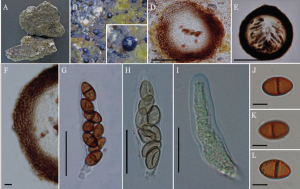Endococcus rugulosus Nyl., Mém. Soc. Sci. Nat. Cherbourg 3: 193 (1855), Index Fungorum number: IF 119447
≡ Verrucaria rugulosa Borrer ex Leight., The British species of angiocarpous lichens: 47 (1851)
≡ Microthelia rugulosa (Borrer ex Leight.) Mudd, A manual of British lichens: 306 (1861)
Habitat on lichen thallus on old walls. Sexual morph: Ascomata 180–260 µm high × 165–250 µm diam., solitary or scattered, wall dark brown to black, semi-immersed, globose to subglobose, smooth, coriaceous, ostiolate. Ostiole usually widely porate, shortly papillate or epapillate, ostiolar canal filled with periphyses. Peridium 30–45 µm diam., comprising several layers of thick-walled, heavily pigmented, small, dark brown to black cells of textura angularis. Hamathecium without pseudoparaphyses. Asci 67–75 × 14–18 µm (x̄ = 72.6 × 16 µm), 8-spored, bitunicate, fissitunicate, clavate to sub-cylindrical, with short furcate, broad pedicel, thickened and rounded at apex, with an ocular chamber. Ascospores 14–16 × 7–9 µm (x̄ = 15.6 × 7.6 µm), uniseriate or biseriate, partially overlapping, brown to chestnut brown, ellipsoidal with broadly rounded ends, 1-septate, slightly constricted at the septum, verruculose, thick-walled, lacking a sheath. Asexual morph: Undetermined.
Material examined: UK. East Sussex: on lichen thallus on old walls, W. Borrer (K(M): 155758, isotype).
Notes: Fungi formerly referred to Tichothecium, fall into two groups, based on ascus structure (Hawksworth 1979). Those with 4- or 8-spored, bitunicate asci are placed in Endococcus (syn. Discothecium), while those with multi-spored asci, discharging by a bursting of the apex (Hawksworth 1979), are considered to belong to Muellerella. There are two groups of Endococcus; one type with spores that have rounded ends and are hardly constricted at the septum, and another with spores that have somewhat pointed apices and are very markedly constricted at the septum (Hawksworth 1979). Sérusiaux et al. (1999) and Kocourková (2000) suggested that Endococcus species are generally host-specific, and the name E. rugulosus Nyl.. Endococcus rugulosus (≡ Verrucaria rugulosa) was referred to the genus Verrucaria, family Verrucariaceae by Borrer ex Leight (1815) (Hawksworth 1979). Endococcus was placed in the order Dothideales by Hawksworth (1979). Lumbsch & Huhndorf (2010) and Hyde et al. (2013) placed Endococcus in Dothideomycetes genera incertae sedis. In the present study we refer it to the family Lichenotheliaceae based on morphological similarity with the type species of Lichenothelia (Lichenothelia scopularia (Nyl.) D. Hawksw.), which colonizes diverse types of rock substrates and is sometimes found on lichens. Due to the perithecioid ascomata with widely porate ostioles, globose to broadly clavate asci and hyaline or brown, 1-septate ascospores, we regard Endococcus as a distinct genus in the family Lichenotheliaceae. Index Fugorum lists79 species in this genus but none have had their placement confirmed by molecular data. From studies of morphology they have been put into different families, hence this group is obviously
polyphyletic. In this study we only re-examined the type species, Endococcus rugulosus.
Fig. 1. Endococcus rugulosus (isotype). A Herbarium specimen. B Ascomata on host substrate. C Close up of ascoma. D, E Sections
of ascomata. F Close up of the peridium. G–I Asci with short, broad pedicel, containing 8 ascospores. J–L Verruculose ascospores with
rounded ends. Scale bars: D–E=60 µm, F=10 µm, G–H=20 µm, J–L=10 µm.

